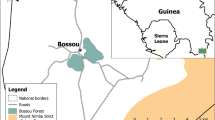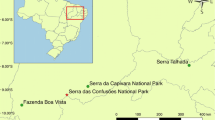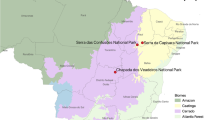Abstract
Selection and transport of objects to use as tools at a distant site are considered to reflect planning. Ancestral humans transported tools and tool-making materials as well as food items. Wild chimpanzees also transport selected hammer tools and nuts to anvil sites. To date, we had no other examples of selection and transport of stone tools among wild nonhuman primates. Wild bearded capuchins (Cebus libidinosus) in Boa Vista (Piauí, Brazil) routinely crack open palm nuts and other physically well-protected foods on level surfaces (anvils) using stones (hammers) as percussive tools. Here we present indirect evidence, obtained by a transect census, that stones suitable for use as hammers are rare (study 1) and behavioral evidence of hammer transport by twelve capuchins (study 2). To crack palm nuts, adults transported heavier and harder stones than to crack other less resistant food items. These findings show that wild capuchin monkeys selectively transport stones of appropriate size and hardness to use as hammers, thus exhibiting, like chimpanzees and humans, planning in tool-use activities.




Similar content being viewed by others
References
Binford L (1981) Bones: ancient men and modern myths. Academic Press, New York
Biro D, Sousa C, Matsuzawa T (2006) Ontogeny and cultural propagation of tool use by wild chimpanzees at Bossou, Guinea: case studies in nut cracking and leaf folding. In: Matsuzawa T, Tomonaga M, Tanaka M (eds) Cognitive development in chimpanzees. Springer, Tokyo
Boesch C, Boesch H (1983) Optimisation of nut-cracking with natural hammers by wild chimpanzees. Behaviour 83:265–286
Boesch C, Boesch H (1984) Mental map in wild chimpanzees: an analysis of hammer transports for nut cracking. Primates 25(2):160–170
Boesch C, Boesch-Achermann H (2000) The chimpanzees of the Taï forest. Oxford University Press, Oxford
Byrne RW (2004) The manual skills and cognition that lie behind hominid tool use. In: Russon AE, Begun DR (eds) The evolution of thought: evolutionary origins of great ape intelligence. Cambridge University Press, Cambridge, pp 31–44
Cleveland A, Rocca AM, Wendt EL, Westergaard GC (2004) Transport of tools to food sites in tufted capuchin monkeys (Cebus apella). Anim Cogn 7:193–198
Davidson I, McGrew WC (2005) Stone tools and the uniqueness of human culture. J R Anthrop Inst 11:793–817
Falotico T (2006) Estudo experimental do uso de ferramentas para quebra de frutos encapsulados por macacos-prego (Cebus apella) em semi-liberdade. Master’s Thesis, University of São Paulo, São Paulo
Fragaszy D, Visalberghi E (1989) Social influences on the acquisition and use of tools in tufted capuchin monkeys (Cebus apella). J Comp Psychol 103:159–170
Fragaszy D, Visalberghi E (2001) Recognizing a swan: socially-biased learning. Psychologia 44:82–98
Fragaszy D, Izar P, Visalberghi E, Ottoni E, Gomes de Oliveira M (2004a) Wild capuchin monkeys (Cebus libidinousus) use anvils and stone pounding tools. Am J Primatol 64:359–366
Fragaszy D, Fedigan L, Visalberghi E (2004b) The complete capuchin. The biology of the genus Cebus. Cambridge University Press, Cambridge
Gunst N, Boinski S, Fragaszy D (2008) Acquisition of foraging competence in wild brown capuchins (Cebus apella), with special reference to conspecifics foraging artefacts as an indirect social influence. Behaviour 145:195–229
Hannah AC, McGrew WC (1987) Chimpanzees using stones to crack open oil palm nuts in Liberia. Primates 28(1):31–46
Isaac GL (1984) The archaeology of human origins: studies of the lower Pleistocene in East Africa, 1971–1981. Adv Wild Archaeol 3:1–86
Jalles-Filho E, da Cunha RGT, Salm RA (2001) Transport of tools and mental representation: is capuchin monkey tool behavior a useful model for Plio-Pleistocene hominid technology? J Hum Evol 40:365–377
Janson CH (1998) Experimental evidence for spatial memory in foraging wild capuchin monkeys, Cebus apella. Anim Behav 55:1229–1243
Janson CH (2007) Experimental evidence for route integration and strategic planning in wild capuchin monkeys. Anim Cogn 10:341–356
Laland K, Odling-Smee J, Feldman M (2000) Niche construction, biological evolution, and cultural change. Behav Brain Sci 23:131–146
Liu Q, Simpson K, Izar P, Ottoni E, Visalberghi E, Fragaszy D (2009) Kinematics and energetics of nut-cracking in wild capuchin monkeys (Cebus libidinosus) in Piauí, Brazil. Am J Phys Primatol 138:210–220
Potts R (1991) Why the Oldowan? Plio-Plistocene tool making and the transport of resources. J Anthropol Res 47:153–176
Sakura O, Matsuzawa T (1991) Flexibility of wild chimpanzee nut-cracking behavior using stone hammers and anvils: an experimental analysis. Ethology 87:237–248
Sugiyama Y, Koman J (1979) Tool-using and making behavior in wild chimpanzees at Bossou, Guinea. Primates 20:513–524
Visalberghi E, Fragaszy D, Ottoni E, Izar P, de Oliveira MG, Andrade FRD (2007) Characteristics of hammer stones and anvils used by wild bearded capuchin monkeys (Cebus libidinosus) to crack open palm nuts. Am J Phys Anthropol 132:426–444
Visalberghi E, Sabbatini G, Spagnoletti N, Andrade FRD, Ottoni E, Izar P, Fragaszy D (2008) Physical properties of palm fruits processed with tools by wild bearded capuchins (Cebus libidinosus). Am J Primatol 70:1–8
Visalberghi E, Addessi E, Truppa V, Spagnoletti N, Ottoni E, Izar P, Fragaszy D (2009) Selection of effective stone tools by wild capuchin monkeys. Curr Biol (in press)
Wynn T, McGrew WC (1989) An ape’s view of the Oldowan. Man 24:383–398
Acknowledgments
Permission to work in Brazil granted by IBAMA and CNPq to D.F. and E.V. Thanks to Fundacão BioBrasil and to the Familia M for permission to work at Boa Vista and to Jozemar, Arizomar, and Junior for their assistance in the field. Thanks to Luca Mantovani for his help during study 1. Funded by National Geographic Society, Leakey Foundation, CNPq, FAPESP, CNR, EU-Analogy (STREP Contr. No. 029088), Università La Sapienza di Roma, and Ethoikos. D. Fragaszy acknowledges support of Kyoto University, where she was Visiting Professor in the Faculty of Letters during the period of writing this manuscript. We also thank Bill McGrew and two anonymous referees whose comments greatly improved the manuscript.
Author information
Authors and Affiliations
Corresponding author
About this article
Cite this article
Visalberghi, E., Spagnoletti, N., Ramos da Silva, E.D. et al. Distribution of potential suitable hammers and transport of hammer tools and nuts by wild capuchin monkeys. Primates 50, 95–104 (2009). https://doi.org/10.1007/s10329-008-0127-9
Received:
Accepted:
Published:
Issue Date:
DOI: https://doi.org/10.1007/s10329-008-0127-9




